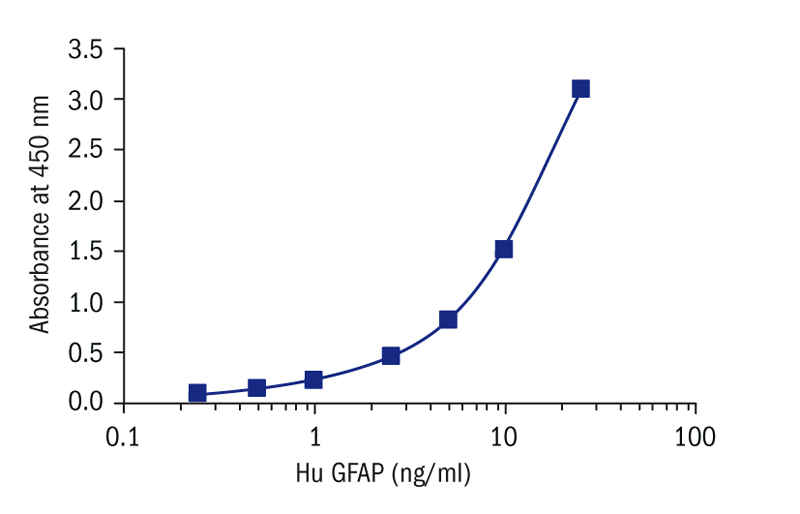Type
Sandwich ELISA, Biotin-labelled antibody
Applications
Serum, Plasma-EDTA, Plasma-Heparin, Plasma-Citrate, Cerebrospinal fluid
Sample Requirements
35 µl/well
Shipping
At ambient temperature. Upon receipt, store the product at the temperature recommended below.
Storage/Expiration
Store the complete kit at 2–8°C. Under these conditions, the kit is stable until the expiration date (see label on the box).
Calibration Curve
Calibration Range
0.25–25 ng/ml
Limit of Detection
0.045 ng/ml
Intra-assay (Within-Run)
n = 8; CV = 5.1%
Inter-assay (Run-to-Run)
n = 7; CV = 5.7%
Spiking Recovery
102,90%
Dilution Linearity
100,60%
Crossreactivity
- bovine Not tested
- cat Not tested
- dog Not tested
- goat Not tested
- hamster Not tested
- horse Not tested
- human Not tested
- chicken Not tested
- monkey Not tested
- mouse Not tested
- pig Not tested
- rabbit Not tested
- rat Not tested
- sheep Not tested
Features
- It is intended for research use only
- The total assay time is about 5 hours
- The kit measures GFAP in serum, cerebrospinal fluid (CSF) and plasma
- Assay format is 96 wells
- Quality Controls are human serum based
- Standard is purified native protein based
- Components of the kit are provided ready to use, concentrated or lyophilized
Research topic
Neural tissue markers
Summary
Glial Fibrillary Acidic Protein (GFAP), as a member of the cytoskeletal protein family, is the principal 8-9 nm intermediate filament in mature astrocytes of the central nervous system (CNS). GFAP is a monomeric molecule with a molecular mass between 40 and 53 kDa and an isoelectric point between 5.7 and 5.8. GFAP is highly brain specific protein that is not found outside the CNS. Some studies showed that GFAP is released into the blood very soon after traumatic brain injury (TBI), that GFAP is related to brain injury severity and outcome after TBI and that GFAP is not released after multiple trauma without brain injury.
In the CNS following injury, either as a result of trauma, disease, genetic disorders, or chemical insult, astrocytes become reactive and respond in a typical manner, termed astrogliosis. Astrogliosis is characterized by rapid synthesis of GFAP. GFAP normally increases with age and there is a wide variation in collection and processing of human brain tissue. Thanks to the high brain specificity and early releasing from CNS after TBI, GFAP might be suitable marker for early diagnostics.
Areas of investigation: Brain injury, Ischemic stroke.
Find documents for the lot
Example Instructions for Use (RUO)
Example Instructions for Use (RUO)
Safety Information (RUO)
MSDS (RUO)
MSDS (RUO)


